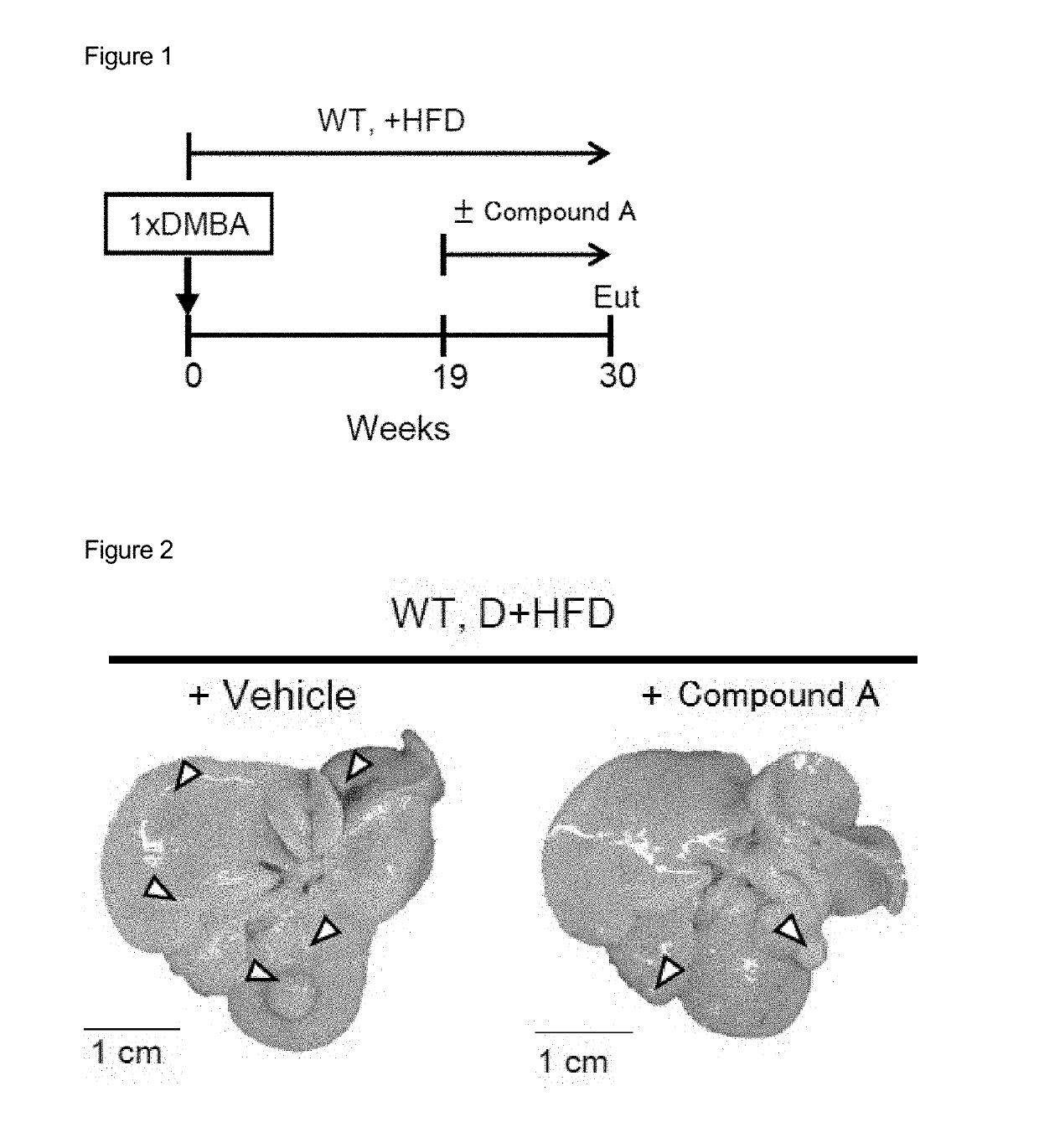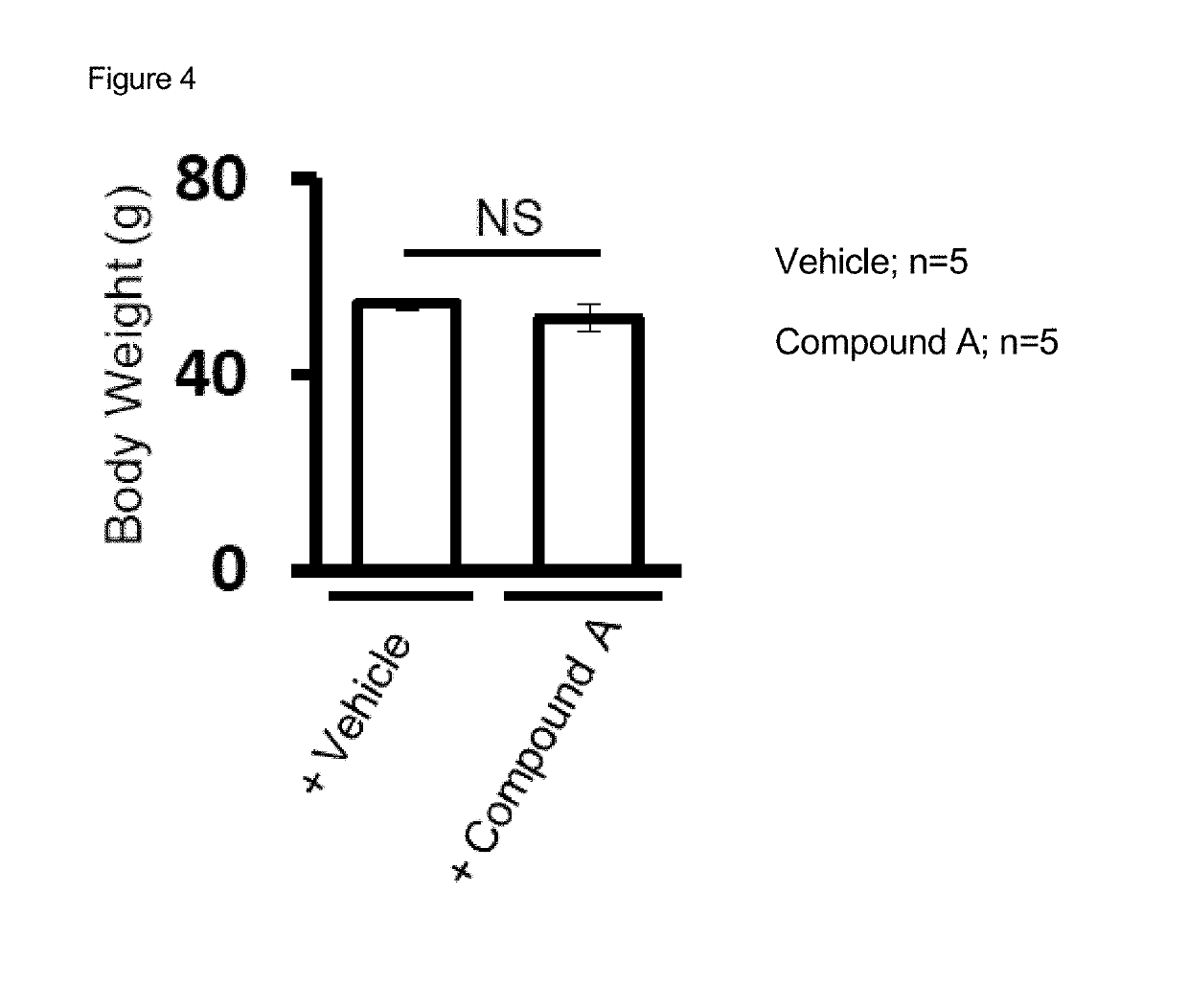Use of EP4 receptor antagonists for the treatment of NASH-associated liver cancer
a technology of ep4 receptor and liver cancer, which is applied in the direction of heterocyclic compound active ingredients, organic chemistry, drug compositions, etc., can solve the problems of liver cancer, nash and diseases associated with liver cancer, no available nash therapy, and increased risk of diabetes, etc., to inhibit liver tumor development, high fat, and upregulation
- Summary
- Abstract
- Description
- Claims
- Application Information
AI Technical Summary
Benefits of technology
Problems solved by technology
Method used
Image
Examples
example 1
[0119]Compound A inhibited the growth of liver cancer in a high fat diet-induced NASH-associated mouse liver cancer model.
Animal Experiments
[0120]C57 / BL6 mice were purchased from CLEA Japan Inc. The Tlr2− / − mice (C57 / BL6) were purchased from Oriental Yeast Co. Ltd.
Histology and Immunofluorescence Analysis
[0121]Hematoxylin and eosin staining and immunofluorescence analysis were performed as previously described (Yoshimoto et al., Nature, 2013, 499:97-101).
Immune Cell Isolation
[0122]Immune cells were obtained from mouse livers and were subjected to measuring cytokine production and flow cytometric analysis.
Statistical Analysis
[0123]Data were analyzed by unpaired t-test with Welch correction (two-side) or Man-Whitney test (two-side). P values less than 0.05 were considered significant. “NS” indicates not significant.
Study Results
[0124]This mouse model was developed by treating with DMBA, 7,12-dimethylbenz(a)anthracene, and by feeding a high fat diet (HFD) (Ootani 2013). In this mouse m...
example 2
[0127]Compound A in combination with a PD-1 antibody is expected to show a higher anti-tumor efficacy than Compound A alone in the HFD-induced NASH-associated mouse liver cancer model.
Study Methods
[0128]The same mouse model as Example 1 would be used to test the efficacy of Compound A in combination with a PD-1 antibody in HFD-induced NASH-associated mouse liver cancer model. Accordingly, Example 1 is repeated except a PD-1 antibody is also administered with Compound A in the Compound-A treated group.
Results
[0129]Compound A in combination with the PD-1 antibody therapy is expected to show higher anti-tumor efficacy than the Compound A-treated mice of Example 1 in the HFD-induced NASH-associated mouse liver cancer model.
example 3
[0130]Compound B treatment is expected to inhibit the growth of liver cancer in the HFD-induced NASH-associated mouse liver cancer model.
Study Methods
[0131]The same mouse model as Example 1 would be used to test the efficacy of Compound B. Thus, Example 1 is repeated except Compound B is used instead of Compound A.
Study Results
[0132]Compound B therapy is expected to inhibit the growth of liver cancer in the HFD-induced NASH-associated mouse liver cancer model. Compound B is expected to control the immune cell function in tumor tissue in the same manner as Compound A in Example 1.
Conclusion
[0133]EP4 antagonist Compound B is expected to inhibit the growth and development in NASH-associated mouse liver cancer model consistent with the results of Compound A in Example 1. Compound B treatment to the mouse model is expected to increase frequencies of DC subtype which is essential for the anti-cancer immune response (CD103+) and decrease the expression of PD-1 on cytotoxic CD8+ T cells in ...
PUM
| Property | Measurement | Unit |
|---|---|---|
| weight | aaaaa | aaaaa |
| weight | aaaaa | aaaaa |
| weight | aaaaa | aaaaa |
Abstract
Description
Claims
Application Information
 Login to View More
Login to View More - R&D
- Intellectual Property
- Life Sciences
- Materials
- Tech Scout
- Unparalleled Data Quality
- Higher Quality Content
- 60% Fewer Hallucinations
Browse by: Latest US Patents, China's latest patents, Technical Efficacy Thesaurus, Application Domain, Technology Topic, Popular Technical Reports.
© 2025 PatSnap. All rights reserved.Legal|Privacy policy|Modern Slavery Act Transparency Statement|Sitemap|About US| Contact US: help@patsnap.com



